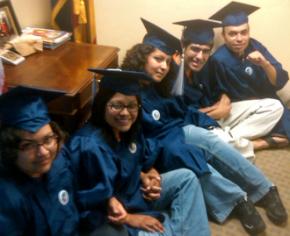The DREAM Act front and center
On May 17, a group of Latino students made headlines by sitting in at the Tucson, Ariz., office of Republican Sen. John McCain. Three undocumented students and a fourth who was a legal citizen were ultimately arrested and charged with trespassing--the three undocumented teenagers were later taken into custody by Immigration and Customs Enforcement.
The protesters were bringing attention to the plight of an estimated 65,000 undocumented students in the U.S. and calling for the passage of the Development, Relief and Education for Alien Minors (DREAM) Act, which would offer undocumented minors a path to citizenship, under conditions of college attendance or military service.
In this statement, , president of the Mexican American Political Association and Hermandad Mexicana Latinoamericana, welcomes the recent protests and looks at the politics of the DREAM Act.
THE MEXICAN American Political Association (MAPA) and the Hermandad Mexicana Latinoamericana make a call for full support for the students and youth who are demonstrating courage in the struggle for legislation that they interpret will provide them an option to obtain legal immigration status. The legislation is the DREAM Act, which proposes to permit those students and youth who arrived to the U.S. at an early age without legal status and have completed high school the option to apply for legal status while attending college or serving some branch of the U.S. military.
Notwithstanding many concerns with the legislation raised by many organizations nationally, particularly those that oppose mandatory military service, obligatory military registration, the draft, and the use of the military and war to resolve international disputes, MAPA and Hermandad go on record in support of the youth who are defining their own options through courageous acts of political/civic action.
The DREAM Act is not without controversy, however, and both MAPA and Hermandad have raised concerns about the legislation since the beginning. The original version of the DREAM Act was actually the best, in that it did not include military service as an option to obtain legal status, but instead listed the pursuit of higher education, which included vocational, and community service as the criteria to qualify for eligibility.

It is now no secret that the Pentagon had a hand in fashioning later versions of the legislation with the willing help of congressional legislators. Historically people of color have been easy prey for conscription, the draft and even the "all-voluntary" military service considering the financial inducements on the one hand, and the dire poverty statistics of these communities on the other.
The various branches of the U.S. military have experienced increasing difficulty in meeting their goals for recruitment, and in the face of multiple wars of a prolonged character, the military is hard-pressed to find sufficient willing adherents to its brassy and provocative slogans like "Be all you can be."
It should also be acknowledged that the vast majority of immigrant youth, particularly Latino, do not and will not attend college (less than 10 percent), nearly 30 percent do not complete high school, and less than 40 percent who enter college complete the instructional program with a degree. These are horrific statistics on the downside of this social dynamic that cannot, and should not, be ignored when we are considering immigration-related legislation to address the issue of legal status of our youth and family members.
It is for these reasons that MAPA and Hermandad only conditionally support the DREAM Act, and advocate for the cleansing of the bill of its military service clause, or minimally, to return the community service option as an integral part of the legislation.
When people talk of "choice" in the DREAM Act, but ignore the statistics indicated above, and leave out of the legislation other viable alternatives such as community service to permit a path to legalization, in reality, they are opposed to real choice and real options.
For now, however, we are called upon to support our youth and students who are defining the struggle for options by their courageous actions, while we continue the debate about the best form of the DREAM Act that should be enacted by the U.S. Congress.


